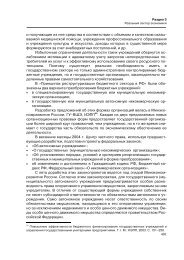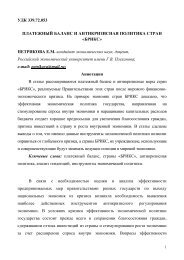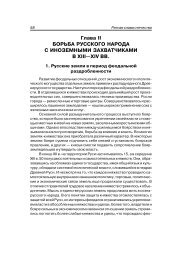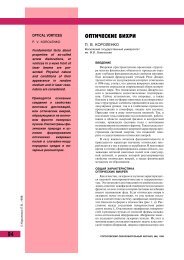Ensuring Strategic Stability in the Past and Present:
Ensuring Strategic Stability in the Past and Present:
Ensuring Strategic Stability in the Past and Present:
You also want an ePaper? Increase the reach of your titles
YUMPU automatically turns print PDFs into web optimized ePapers that Google loves.
Chapter 7: Nuclear Deterrence as a Comb<strong>in</strong>ation of “Vulnerability-Invulnerability”Interaction <strong>in</strong> <strong>the</strong> nuclear area largely rests not just on hardware, but also on nuclear deterrenceformulas <strong>and</strong> concepts. The nuclear deterrence concept has a deep <strong>in</strong>ternal contradiction. On <strong>the</strong>one h<strong>and</strong>, it is aimed to m<strong>in</strong>imize <strong>the</strong> likelihood of a war by mak<strong>in</strong>g it abysmally destructive. Forthis purpose <strong>the</strong> state must have <strong>the</strong> nuclear forces that provide for annihilation of <strong>the</strong> adversary<strong>and</strong> <strong>in</strong>fliction of irreparable damage to <strong>the</strong> enemy even if such a state is exposed to a first nuclearstrike. On <strong>the</strong> o<strong>the</strong>r h<strong>and</strong>, <strong>in</strong> order to atta<strong>in</strong> deterrence, it is necessary to make <strong>the</strong> threat of useof nuclear weapons credible <strong>and</strong> conv<strong>in</strong>c<strong>in</strong>g. To this end, it is necessary to make nuclear war lessdevastat<strong>in</strong>g, but at <strong>the</strong> same time more probable. Such an approach constitutes <strong>the</strong> basis of <strong>the</strong>concept of limitation of nuclear war—by <strong>the</strong> scope of <strong>the</strong> <strong>the</strong>ater of military operations or by <strong>the</strong>rules of limited strategic exchange. In order to <strong>in</strong>crease <strong>the</strong> credibility of <strong>the</strong> likelihood of <strong>the</strong>use of nuclear weapons, countries built up <strong>the</strong> counterforce arms of <strong>the</strong>ir strategic nuclear forces(SNF) <strong>and</strong> developed tactical (<strong>and</strong> operational-tactical) nuclear weapons. To put it o<strong>the</strong>rwise, aswas mentioned above, along with <strong>the</strong> nuclear retaliation potential, a number of states have beendevelop<strong>in</strong>g real warfare potential, <strong>and</strong> every new round of such activities, as a rule, was <strong>in</strong>itiatedby <strong>the</strong> United States. And it is true that military-strategic <strong>and</strong> operational <strong>in</strong>centives <strong>and</strong><strong>the</strong> scientific-technical capabilities for such capacity build<strong>in</strong>g are practically unlimited. And <strong>the</strong>limitations imposed by <strong>the</strong> sides to provide for strategic stability <strong>in</strong> <strong>the</strong> general <strong>in</strong>terest are primarily<strong>the</strong> derivatives of political decisions, which are based on serious scientific-technical <strong>and</strong>operational-strategic expertise.Many experts believe that <strong>in</strong> reality <strong>the</strong>re is no contradiction between <strong>the</strong> two aspects of nucleardeterrence: <strong>the</strong> better <strong>the</strong> country’s preparedness for war, <strong>the</strong> wider is <strong>the</strong> range of tasks that canbe fulfilled by its nuclear forces, <strong>and</strong> <strong>the</strong> more effective is its capacity to deter <strong>the</strong> adversary’sassault. However, <strong>the</strong> o<strong>the</strong>r side <strong>in</strong>evitably perceives <strong>the</strong> measures designed to maximize actualwarfight<strong>in</strong>g capacity as proof of aggressive <strong>in</strong>tentions <strong>and</strong> as an attempt to come out of <strong>the</strong> bl<strong>in</strong>dalley of mutually assured destruction through an opportunity to pursue <strong>and</strong> w<strong>in</strong> a nuclear war.Obviously, <strong>the</strong>re are considerable psychological (political-psychological) problems related to <strong>the</strong>acknowledgement of <strong>the</strong> existence of nuclear stalemate based on <strong>the</strong> presumption of mutuallyassured destruction; those problems were perceived by <strong>the</strong> Soviet Union <strong>and</strong> <strong>the</strong> United States <strong>in</strong><strong>the</strong> 1960s <strong>and</strong> 1970s. 62The fear on which nuclear deterrence rests has at least two guises: <strong>the</strong> fear of nuclear retaliation(“fear-1”) <strong>and</strong> <strong>the</strong> fear of los<strong>in</strong>g to <strong>the</strong> o<strong>the</strong>r side (“fear-2”). “Fear-2” creates an extremely dangerous<strong>and</strong> destabiliz<strong>in</strong>g atmosphere, if triggered by <strong>the</strong> threat of <strong>the</strong> o<strong>the</strong>r side’s preemptive disarm<strong>in</strong>gstrike. It is this guise of fear that encourages <strong>the</strong> arms race <strong>and</strong> whips up <strong>the</strong> qualitativeimprovement of real warfare capacity. However, such steps just <strong>in</strong>vigorate <strong>the</strong> o<strong>the</strong>r side’s apprehensionthat it is deal<strong>in</strong>g with an aggressor. F<strong>in</strong>ally, such fear may play a fatal role <strong>in</strong> <strong>the</strong> event ofserious aggravation of <strong>the</strong> crisis situation <strong>and</strong> may give an impetus to delivery of a preemptivestrike.34<strong>Ensur<strong>in</strong>g</strong> <strong>Strategic</strong> <strong>Stability</strong> <strong>in</strong> <strong>the</strong> <strong>Past</strong> <strong>and</strong> <strong>Present</strong>: Theoretical <strong>and</strong> Applied Questions
















